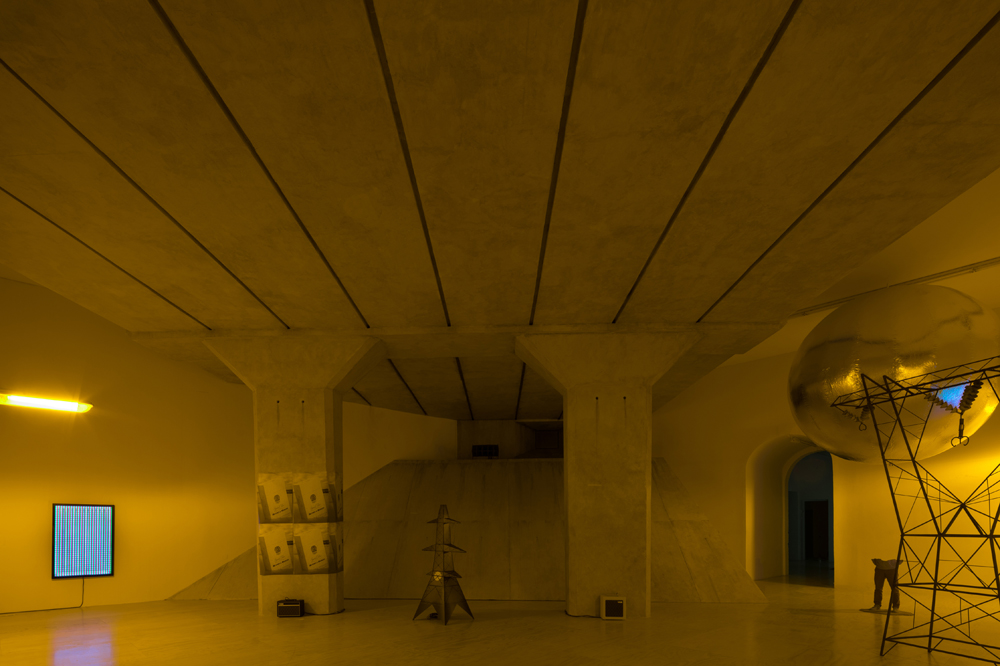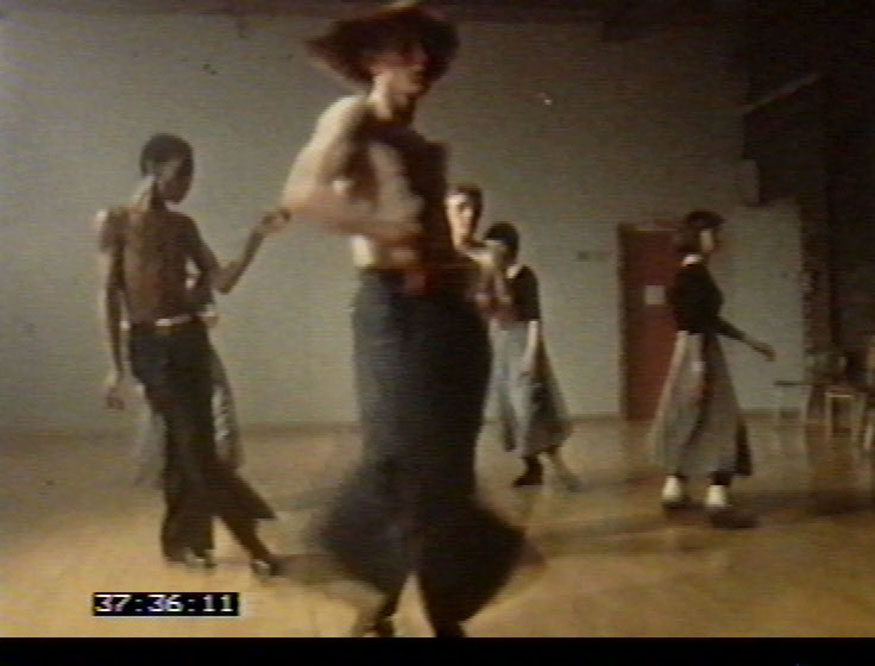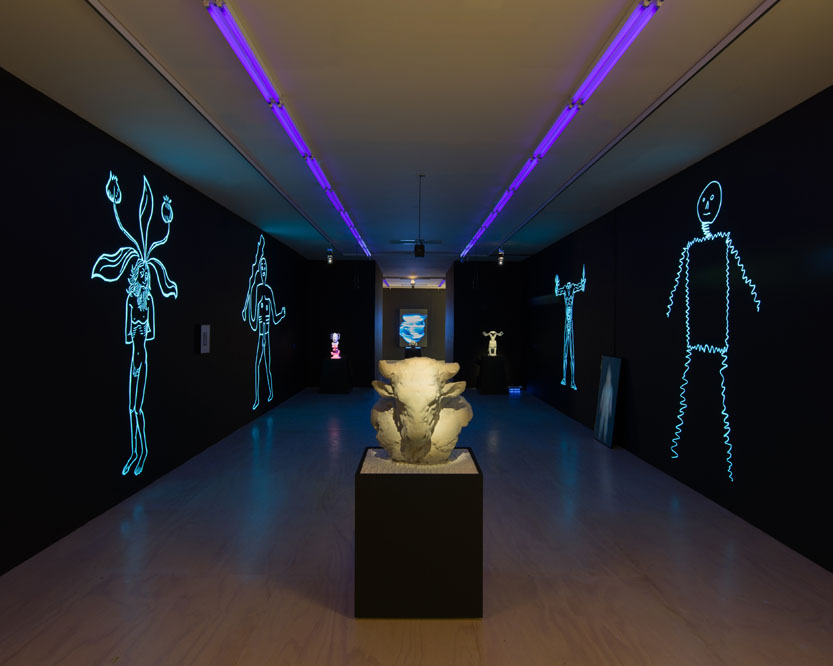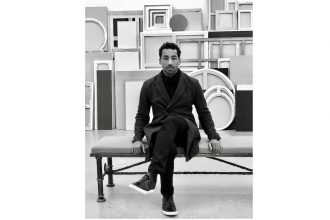My personal experience [is that] intranational tourism is radically constricting, and humbling in the hardest way – hostile to my fantasy of being a real individual, of living somehow outside and above it all … To be a mass tourist, for me, is to become a pure late-date American: alien, ignorant, greedy for something you cannot ever have, disappointed in a way you can never admit.
– David Foster Wallace, “Consider the Lobster”
Let the tourist be our model as we wade through British popular culture in Mark Leckey’s survey exhibition, Containers and Their Drivers, at MoMA/PS1. The tourist speaks bits of local language, and collects funny, lewd, or poetic phrases; she affords herself the time to wander as a spectator and she fantasizes; “Could I live and work here?” She is cousin to the flâneur who, through idle and detached observation, is able to participate more richly in the public she observes. While self-awareness is a source of great pleasure for the flâneur, however, the same experience makes the tourist anxious. She worries whether her experience is ever really hers alone.
Leckey’s work comprises dreamlike portraits that plunge us into the cultural subconscious and its manufacturing of taste. It sparks a nervous relationship to belonging, which, for the tourist, is about ownership and authenticity; while these theme echo Leckey’s preoccupations, he explores subcultures and domesticity exhibit with satirical resolve. Organized by curators Peter Eleey and Stuart Comer, the show traces the artist’s output from 1999 to the present, highlighting how Leckey continually adapts his artistic identity to a shifting cultural paradigm. He performs the role of impresario, collector, guru-lecturer, memoirist, distributor, and brand ambassador. Each work references others from the oeuvre, mingling autobiography with the histories of technology and British popular culture. Appropriately, to the American tourist, these historical foils appear chiefly alien and dispossessing.
The exhibition is propositional in nature, a wink-wink tour guide’s trick to take Leckey at his word. The work is littered with wide-ranging facts, often driven by his own compulsive interests, and veracity is replaced by a romance with vernacular culture and language. Vernacular is not necessarily a form of truth; rather, it represents a cultural peripheral vision, a faculty that allows us to react instinctively to the historical phenomena that inscribe our perspective. Tourists that we are, we have to depend on Leckey’s knowledge of the local language.
Fiorucci Made Me Hardcore (1999), Leckey’s first mature work as an artist, defines his languorous approach. The short film is a portrait of underground music and dance culture in the UK during the ‘70s, ‘80s, and ‘90s: VHS dreams of sweaty ravers, bouncing crowds, rollerskaters, and teens in blue jeans innocently menacing the streets. Private clubs counter-pose public space as individual portraits withdraw from, and then absorb back into, the group. Music samples from the video echo in Sound System sculptures (2001-12) and imagery appears in other works and ephemera in the exhibition. The tourist’s insecurity originates in the nature of subcultures themselves: inaccessible utopias of immersion and nostalgia, categorically apart from a general public, tending to be more self-determined, individualized, alternative, against.
In other works, Leckey questions the soft-authority of globally ubiquitous brands. Faced with her isolation from a cultural ecosystem brands represent, the tourist projects an image that reflects her own desire to fit in. And GreenScreenRefrigerator (2010-16) offers an all-inclusive package: an installation that immerses us in Samsung’s brand universe. A smart-fridge and speakers stand totemic in a green-screen studio, flanked by more electronic products. Leckey’s Freon-altered voice channels the refrigerator, and intones a mythological origin story; the appliance was purpose-built to enhance home-life, but the same AI mechanisms that make it an efficient crisper of greens, also imbue it with filial duty and a desire to belong. With its selling-points, it entreats us desperately, for a home: it knows just when the milk has turned.
Home, but unheimlich: there’s a familiar paranoia about this incipient AI. While recognizable branding grants the tourist access to a sort of cultural universal, Leckey frames the fridge tragically, like the monster in Mary Shelley’s Frankenstein. As elsewhere in the exhibition, Leckey subverts our corporate rhetoric, evoking a secular spiritualism that brings banal objects to life. Late-day capitalism sublimates desire into ambiance, which factors into Leckey’s language. However, quick to be silly or impetuous, Leckey’s script humorously highlights the clunky incompatibility between us and our objects, like the tourist reconciling the unseemly moods of a roommate.
Delving into the brackish transition between analogue and digital, Leckey analyzes our understanding of an object’s essence or thing-ness. In UniAddDumThis (2014), he further plots the mercurial nature of authenticity. The mini-exhibition recreates The Universal Addressability of Dumb Things, a show Leckey organized in 2013. Preferring the title “aggregator” over “curator,” he collected antiquities, artworks, everyday and historical objects, and, following the exhibition, he 3D-scanned most of them. In effect, the exhibition is a database, which can be reconstituted and recombined at will. The 3D-printed sculpture Bourgeois/Cyberman (2014) combines Louise Bourgeois’s Nature Study (1986), an otherwise headless dog statue with six human breasts, and the helmet of the robot villains from Dr. Who. By definition, a dumb thing can’t speak – but Leckey’s database attests to the fungible assets of an object. Uninhibited by materials, sexuality, or gender, identity can be freely rearranged within Leckey’s brute taxonomy.
Like a true futurist, Leckey is animated equally by alienation and wonder. The volatile combination pervades the various video installations in the exhibition with joy and malaise. It pushes the life-like nature of images into the uncanny valley, the unsettling moment when computer animation is indistinguishable from the real. In a lecture video Cinema-in-the-Round (2007), stills of Homer Simpson’s shoe accompany an un-cited quotation: “These feet, so unreal, are curiously human. They are ironic feet, and therefore, a supreme quality in cartooning, touchingly pathetic.” This unsettling of the familiar image is especially relevant for the tourist, a digital native, who – as part of her pilgrimage – accesses the heavily represented past via the networked free-for-all of the present. Her experience is of a perpetual caricature of history: curiously human, touchingly pathetic. Later on, wink-wink editing further blurs reality and fiction, when the lecture audio continues, disconnected from a scene in which Leckey looks at the camera – the smart-aleck – and takes a sip from a Heineken.
Upstairs in PS1’s largest gallery, Leckey’s bildungsroman Dream English Kid (2016) turns his speculative vision on himself. A late-20th-century history lurks under a nearly one-for-one recreation of a highway overpass. Industrial street lamps cast a sickly-yellow hue throughout the dreamlike installation, feeling melodramatic and abandoned. The project is based on an eponymous video – Dream English Kid 1964-1999 AD (2015) – which traces cultural and technological developments from the 1960s to 1999, the period of Leckey’s life prior to his artistic maturity. Animated diagrams reimagine a child’s bed as a self-sustaining habitat against a backdrop of cultural, political, and technological shifts. A space station? A bomb shelter? In either case, post-war promise and techno-utopian fantasies are always underwritten by escape. Global trauma is sublimated through childhood innocence, and occasional Oedipal dramas: an anonymous child ogles his ‘70s showgirl mom; the overpass appears in guileless grids of early computer mockups. Y2K is apparently the video’s denouement, though neither the destruction, nor the rebirth of technological society came to pass. It’s when the child calls out for his mother from the back seat of the car that we appreciate the end-of-innocence tale.
Leckey is the impresario of an elusive dreamworld, embodying the assumptions that underwrite our communities of taste. He places himself front-row-center throughout much of his work. Though it might seem like he’s proving his bona fides, his presence makes him an inviting proxy. He’s earnest and enchanting; wry and annoying. He’s drunk on the punch and here for the party, while the tourist’s dram is just a free sample, premised on an eagerness to belong, and a fear of embarrassingly revealing oneself. Like a good host, Leckey straddles the line between generosity and cool ego: a kind of bad role model who leads us through the intoxicating, stultifying subcultures he deals in.
A silhouetted body slowly dissolves against a sunrise sky, toward the end of Fiorucci Made Me Hardcore, installed in a tucked-away, den-like gallery, though its presence is felt throughout the entire exhibition. Here, the image of the tourist has finally come into view. Leading us to the fringes of both subcultures and ontology, Leckey demonstrates that pop operates on a level below the perceptual. Authenticity is a party for Leckey, and the door fee is our right to belong. As the video loops, it’s as if our tourist exited the club at the end of the night, seeing this culture startlingly, bewilderingly, ecstatically for the first time. Perhaps a song got stuck in her head, she hums, “It’s the last time / Oh it’s the last time / Oh, it’s the last time / Oh I’ve never met anyone / Quite like you before.”




























1 Comment